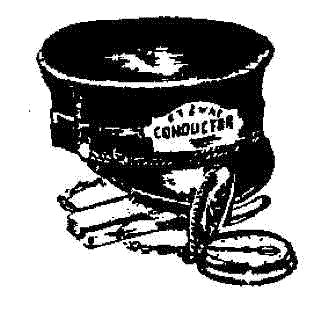 |
Our "Roll of Honor" has been established to recognize the tens of thousands of men and women, living or deceased, and employees on the railroad, interurban and city street railways, and railroad related industries, who contributed so much to our Western New York Railway Heritage. For a $100 donation, a plaque will be mounted on a permanent display board in the Heritage DiscoveRY Center, Buffalo, New York, bearing the name, occupation, railroad (industry) and years of service. Your donation will be applied toward our continuous preservation efforts. |
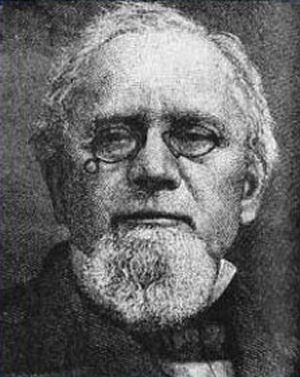 |
This month the Western New York Railway Historical Society is honored to add Mr. Webster Wagner to our "Roll of Honor" Board at the Heritage Discovery Center. The nomination for this gentleman of great distinction comes from Mr. and Mrs. Robert & Edith Warner who wish to honor their Great Grand Uncle Webster Wagner. Webster Wagner was born near Palatine Bridge, New York on October 2nd, 1817. He started in business making wagons with his brother James. After closing the business in 1842, he went to work for the New York Central Railroad as a station agent at the Palatine Bridge depot. During his time at the NYC, he conceived the idea of building sleeping cars for the railroad. Working with Messers. George Gates and T.N. Parmalee of Buffalo New York, he constructed four cars at the cost of $3,200 each. Berths were provided to the passengers with two cheap blankets and pillows. The cars started running on the NYC on September 1st, 1858. Problems existed with the lack of ventilation in the cars but was soon resolved through his development of the clerestory roof. |
| Wagner’s original company was called the New York Central Sleeping Car Company formed in 1858. In 1869, the Gates Sleeping Car Company was absorbed, and the firm was reorganized as the Wagner Palace Car Company. Its original shop buildings were located on Seneca Street in the City of Buffalo. Unfortunately, Webster Wagner did not survive to see his company fully prosper. On January 13, 1882, he was killed in a rail accident when two NYC trains collided near Spuyten DuyVil on the NYC. In 1885, the New York, West Shore & Buffalo Railway went bankrupt and was leased to the NYC. Their large shop complex at Broadway and Bailey was surplus to the NYC’s needs. The Wagner Palace Car Company which was in need of additional manufacturing space, purchased the complex and relocated to the site from their Seneca Street site. The company continued in operation until 1900 when it was merged into the Pullman Company. So, we honor the life and times of William Webster and again wish to thank Robert & Edith Warner for his nomination to be included on our "Roll of Honor." Welcome Aboard! |
| If you would like to honor one of your friends or relatives who work or have worked on a railroad, or even for any of the industries that supplied the railroads, please print out this Roll of Honor Application. It's a great way to remember and distinguish their part of railway history! |

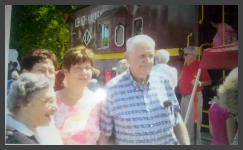 |
This month the Western New York Railway Historical Society is honored to add Mr. Joseph Frederick to its "Roll of Honor." Following are Mr. Frederick's own words on his career. |
| "I worked as a trainman for 15 years (1955-1970). My principle route was the Bridge Pickup out of Manchester, New York to the Suspension Bridge Yard in Niagara Falls, New York. I passed the Williamsville depot many times. I so enjoyed my years on the railroad! This picture was taken at the caboose dedication in Manchester, NY. on August 25, 2013. Pictured are my wife Ann, daughters Marie and Joanne and myself, Joseph Frederick." Welcome aboard! Thanks to Cal Bulman for nominating Mr. Frederick to the "Roll of Honor." |
| If you would like to honor one of your friends or relatives who work or have worked on a railroad, or even for any of the industries that supplied the railroads, please print out this Roll of Honor Application. It's a great way to remember and distinguish their part of railway history! |

| This month we are pleased to add Mr. Joseph N. Weiss to the WNYRHS "Roll of Honor." Mr. Weiss hired on with the New York Central in June of 1965 as a fireman on the extra board. He did this as a summer job while attending college, which allowed him to earn money while giving time off to more senior employees to enjoy summer vacations. He worked every summer, school breaks and weekends from 1965 until 1973. When he wasn't working on the railroad, Mr. Weiss was attending college and eventually received degrees from St. Bonaventure University and Canisius College. As it turned out he passed his engineer's exam the same week he received his Ph.D. from the University at Buffalo. Mr. Weiss says, "In truth, the experience of railroading with so many different crews of individuals provided a greater education than any classroom. Maturity and responsibility came quickly for the kid from the Tiorunda Projects in Cheektowaga." Thanks go to Max Weiss for nominating his father to the "Roll of Honor." |
| If you would like to honor one of your friends or relatives who work or have worked on a railroad, or even for any of the industries that supplied the railroads, please print out this Roll of Honor Application. It's a great way to remember and distinguish their part of railway history! |

| This month, The Western New York Railway Historical Society is honored to add Mr. David E. Coffed to the Railroad Roll of Honor. Mr. Coffed hired on with the New York Central as a fireman in 1965. In 1976 he was promoted to engineer and saw service between Buffalo to Syracuse, Albany and Binghamton. Mr. Coffed also worked five years for Amtrak as a fireman. He witnessed the transition from New York Central to Penn-Central to Conrail before retiring in 1998. We thank Mr. William Coffed for placing David on the Roll of Honor. |
| If you would like to honor one of your friends or relatives who work or have worked on a railroad, or even for any of the industries that supplied the railroads, please print out this Roll of Honor Application. It's a great way to remember and distinguish their part of railway history! |

| memorabilia. Marty enjoyed life and his greatest joy was talking to people. It was a skill that allowed him to talk to anyone and make them feel as if they had been friends forever. Marty aimed high in whatever he did. As a long time firefighter for the City of Batavia he created the "Lives are Precious" Fire Prevention Program, which stressed the importance of fire safety designed especially for children. Marty felt strongly about utilizing actual photographs of burns in his program, as graphic as they might have been, this was the reality of what damage fire can cause and what can happen if safety precautions and respect are not used. The intention was to, hopefully, deeply instill a healthy fear of and respect for fire. He worked as a fire investigator and traveled widely to schools and volunteer fire agencies with his "Lives are Precious" program. Fire trucks from nine different locations were present in his funeral procession. That was the impact this man had on others. Marty was also so veteran of the Army. He served in Germany and, as with his childhood, loved to re-gale people with stories of his years driving big rigs and other adventures, some of which are probably better left unsaid. His respect for the military is reflected in the current Medina Railroad Museum where there are dis-plays of highly detailed naval vessels and a complete Army train running on the layout. He had big plans for running trains to benefit local Armed Forces organizations. Marty's love of the railroad originated as a young boy with his grandfather and Uncle Earl as employees of a railroad and collectors themselves. Marty's collection goes well beyond the walls of the Medina Railroad Museum. His favorite railroad was, hands down, the New York Central and when he was finally able to do so he painted the museum's fleet in the 1948 Century color scheme. His vision was to see the museum's two ex-NYC E-8s pulling a dinner train that reflected the grandeur of the Twentieth Century Limited. Many people over the years scoffed at Marty's ideas but he had a way of making them happen. Of all the things Marty was and all the things he loved, nothing was more important to him than family. His family topped his list of important things and it showed in the way he cared for them and did for them. The museum was not just intended as a legacy for Marty and his entire family but also to those who donated their collections to the museum. Marty wanted everyone to be able to enjoy seeing the beauty of our history on display and felt strongly about the Medina Railroad Museum being a place to assist in educating our children. Marty left us before many of his goals were accomplished but he left a legacy of passion and vision that the current Board of Trustees has vowed to see through! The Medina Railroad Museum and Marty Phelps will be around for a long, long time. Rest in peace my friend. Your legacy is secure. If you would like to honor one of your friends or relatives who work or have worked on a railroad, or even for any of the industries that supplied the railroads, please print out this Roll of Honor Application. It's a great way to remember and distinguish their part of railway history! |

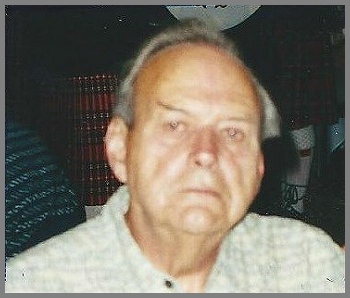 |
The Western New York Railway Historical Society is pleased to be able to add Mr. Kenneth Wylie to the Roll of Honor. Mr. Wylie hired on with the Erie Railroad in 1955 and worked his way up to conductor. He stayed with the railroad through it's merger with the Lackawanna, into Penn Central and left railroading in 1990 as a Conrail employee. Mr. Wylie was known for his generosity in helping others by purchasing items both large and small to help them through their lives while asking nothing in return. Welcome aboard! Our thanks to Mark Klepadlo for making the arrangements to have Mr. Wylie placed on the Roll of Honor. |
| If you would like to honor one of your friends or relatives who work or have worked on a railroad, or even for any of the industries that supplied the railroads, please print out this Roll of Honor Application. It's a great way to remember and distinguish their part of railway history! |

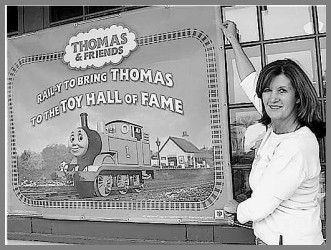 |
In my two tours as chairperson of the Roll of Honor I have written quite a few articles about the inductees. The information has always been supplied by a friend or, more commonly, a family member. I have always tried to bring the individual to life in my articles and portray him or her as best I could as a total person and not describe the person as just a railroader. I often felt it would have been so much easier to write these articles had I actually known the person. Well, I knew Linda Klein. I knew her not only as the Director of Promotions at the Medina Railroad Museum but also as a friend. It did not make it any easier. Trying to describe Linda on paper is kind of like trying to "hold a moonbeam in your hand." (From The Sound of Music) |
| Linda came to Medina in 2001 after she met Marty Phelps, the founder of the museum. They met in California when Marty was visiting there and after a long distance relationship she moved back to New York. Linda was born in Troy. She fell in love with Marty and his vision of a railroad museum but felt it needed a woman's touch, which she gave it and so much more. She joined the team in Medina and wore many hats but officially she was the Director of Promotions. It was Linda that brought Thomas the Tank Engine to the site. That was ten years ago and it was still a money maker this year. Linda had a background in marketing and business management and she used those skills along with her passion to bring together a cohesive group that spawned many successful excursions and really kicked efforts at the museum into high gear. Linda was a perfectionist, detail oriented, hardnosed at times and demanding at times. I know because we clashed on occasion but we always ended any dispute with agreement, compromise and a hug, literally.. When not performing her promotions duties she could be found working on the museum's layout or cleaning the coaches. Nothing was beneath her if it needed to be done and she brought a perfectionist's attitude to everything she did. She had a real artist's touch with scenery and much of what you can see today on the museum's layout is the result of her skills and patience. Besides all her many skills, Linda was fun. She had a wonderful sense of humor that made the excursions we did together even more enjoyable. Her harder business side was balanced by a warmand caring personality. She cared about people and people that really knew her cared about her. You could not help it. We are never ready when someone we care about leaves us. Linda passed away just before the Thomas event in 2011. Per her wishes the event was completed but it wasn't the same. She left behind a legacy that survives at the Medina Railroad Museum and in the hearts of those that knewher. She was one of a kind, my friend and I miss her. It was a great honor for me to be able to write this article and welcome Linda to the Roll of Honor. |
If you would like to honor one of your friends or relatives who work or have worked on a railroad, or even for any of the industries that supplied the railroads, please print out this Roll of Honor Application. It's a great way to remember and distinguish their part of railway history! Allied Chemical & Dye Corporation - 1858-1942 By: Heritage Discovery Center
 Mechanic for the Lehigh Valley and Conrail Railroads - 1948 - 1985 By: Rick Henn
 Web Site Hosting by TRAIN WEB The WNYRHS, Inc. P.O. Box 416, Buffalo, NY. 14231-0416 is an independent organization and has no affiliation with any other local or national group. |